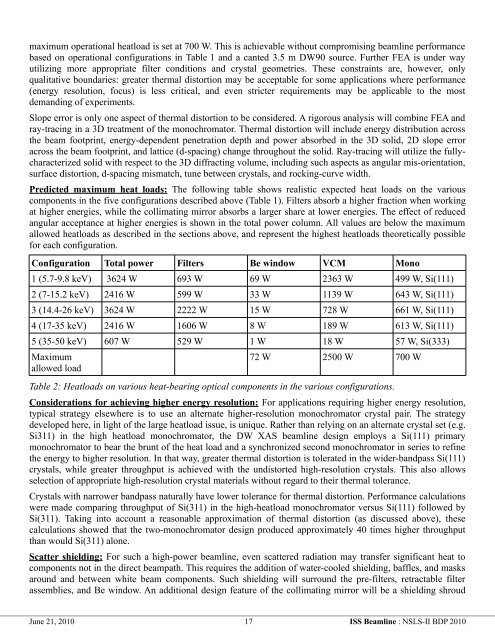Inner Shell Spectroscopy (ISS) - Brookhaven National Laboratory
Inner Shell Spectroscopy (ISS) - Brookhaven National Laboratory
Inner Shell Spectroscopy (ISS) - Brookhaven National Laboratory
Create successful ePaper yourself
Turn your PDF publications into a flip-book with our unique Google optimized e-Paper software.
maximum operational heatload is set at 700 W. This is achievable without compromising beamline performance<br />
based on operational configurations in Table 1 and a canted 3.5 m DW90 source. Further FEA is under way<br />
utilizing more appropriate filter conditions and crystal geometries. These constraints are, however, only<br />
qualitative boundaries: greater thermal distortion may be acceptable for some applications where performance<br />
(energy resolution, focus) is less critical, and even stricter requirements may be applicable to the most<br />
demanding of experiments.<br />
Slope error is only one aspect of thermal distortion to be considered. A rigorous analysis will combine FEA and<br />
ray-tracing in a 3D treatment of the monochromator. Thermal distortion will include energy distribution across<br />
the beam footprint, energy-dependent penetration depth and power absorbed in the 3D solid, 2D slope error<br />
across the beam footprint, and lattice (d-spacing) change throughout the solid. Ray-tracing will utilize the fullycharacterized<br />
solid with respect to the 3D diffracting volume, including such aspects as angular mis-orientation,<br />
surface distortion, d-spacing mismatch, tune between crystals, and rocking-curve width.<br />
Predicted maximum heat loads: The following table shows realistic expected heat loads on the various<br />
components in the five configurations described above (Table 1). Filters absorb a higher fraction when working<br />
at higher energies, while the collimating mirror absorbs a larger share at lower energies. The effect of reduced<br />
angular acceptance at higher energies is shown in the total power column. All values are below the maximum<br />
allowed heatloads as described in the sections above, and represent the highest heatloads theoretically possible<br />
for each configuration.<br />
Configuration Total power Filters Be window VCM Mono<br />
1 (5.7-9.8 keV) 3624 W 693 W 69 W 2363 W 499 W, Si(111)<br />
2 (7-15.2 keV) 2416 W 599 W 33 W 1139 W 643 W, Si(111)<br />
3 (14.4-26 keV) 3624 W 2222 W 15 W 728 W 661 W, Si(111)<br />
4 (17-35 keV) 2416 W 1606 W 8 W 189 W 613 W, Si(111)<br />
5 (35-50 keV) 607 W 529 W 1 W 18 W 57 W, Si(333)<br />
Maximum<br />
allowed load<br />
72 W 2500 W 700 W<br />
Table 2: Heatloads on various heat-bearing optical components in the various configurations.<br />
Considerations for achieving higher energy resolution: For applications requiring higher energy resolution,<br />
typical strategy elsewhere is to use an alternate higher-resolution monochromator crystal pair. The strategy<br />
developed here, in light of the large heatload issue, is unique. Rather than relying on an alternate crystal set (e.g.<br />
Si311) in the high heatload monochromator, the DW XAS beamline design employs a Si(111) primary<br />
monochromator to bear the brunt of the heat load and a synchronized second monochromator in series to refine<br />
the energy to higher resolution. In that way, greater thermal distortion is tolerated in the wider-bandpass Si(111)<br />
crystals, while greater throughput is achieved with the undistorted high-resolution crystals. This also allows<br />
selection of appropriate high-resolution crystal materials without regard to their thermal tolerance.<br />
Crystals with narrower bandpass naturally have lower tolerance for thermal distortion. Performance calculations<br />
were made comparing throughput of Si(311) in the high-heatload monochromator versus Si(111) followed by<br />
Si(311). Taking into account a reasonable approximation of thermal distortion (as discussed above), these<br />
calculations showed that the two-monochromator design produced approximately 40 times higher throughput<br />
than would Si(311) alone.<br />
Scatter shielding: For such a high-power beamline, even scattered radiation may transfer significant heat to<br />
components not in the direct beampath. This requires the addition of water-cooled shielding, baffles, and masks<br />
around and between white beam components. Such shielding will surround the pre-filters, retractable filter<br />
assemblies, and Be window. An additional design feature of the collimating mirror will be a shielding shroud<br />
June 21, 2010 17 <strong>ISS</strong> Beamline : NSLS-II BDP 2010
















